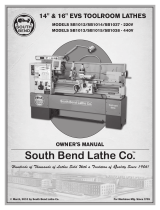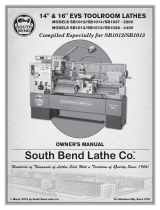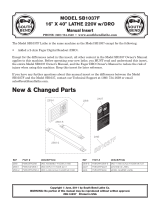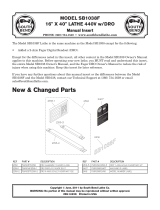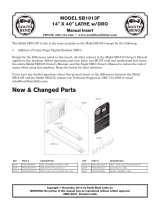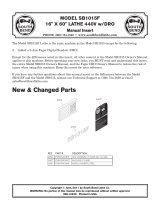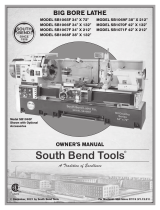
Table of Contents
INTRODUCTION .................................................... 3
About These Machines.........................................3
Foreword ............................................................. 3
Capabilities .........................................................3
Features ..............................................................3
Identification ........................................................ 4
SAFETY ..................................................................5
Understanding Risks of Machinery ....................5
Basic Machine Safety .......................................... 5
Additional Metal Lathe Safety ............................7
PREPARATION ...................................................... 8
Preparation Overview ..........................................8
Things You'll Need ...............................................8
Unpacking ............................................................8
Inventory ..............................................................9
Cleaning & Protecting ....................................... 10
Location ..............................................................11
Physical Environment ........................................ 11
Electrical Installation ........................................11
Lighting ............................................................11
Weight Load ...................................................... 11
Space Allocation ................................................11
Lifting & Moving ................................................ 12
Leveling & Mounting .........................................13
Leveling ............................................................13
Bolting to Concrete Floors ..................................14
Assembly ............................................................14
Lubricating Lathe ..............................................14
Adding Cutting Fluid .........................................15
Power Connection ..............................................15
SB1012 (220V 3-Phase) ......................................15
SB1014, SB1037 (220V 3-Phase) ........................... 15
SB1013 (440V 3-Phase) .......................................... 15
SB1015, SB1038 (440V 3-Phase) ........................... 15
Connecting Power Cord to Lathe ........................ 16
Hardwiring Lathe to Power Source ....................16
Correcting Out-of-Phase Wiring .........................17
Test Run .............................................................17
Spindle Break-In ................................................21
Recommended Adjustments .............................. 22
OPERATION ........................................................23
Operation Overview ........................................... 23
Description of Controls & Components ............24
Main Power Switch ............................................24
Headstock Controls ............................................ 24
Carriage Controls ..............................................24
Control Panel ....................................................25
Tailstock Controls .............................................. 26
Foot Brake ........................................................26
Chuck & Faceplate Mounting ...........................27
Removing Chuck or Faceplate ............................ 27
Mounting Chuck or Faceplate ............................28
Installing and Adjusting Camlock Studs ............. 29
3-Jaw Chuck ....................................................... 30
Changing Jaws .................................................. 31
Mounting Workpiece ..........................................31
4-Jaw Chuck ....................................................... 32
Mounting Workpiece ..........................................32
Tailstock .............................................................32
Moving Along Bedway .......................................33
Using Quill ........................................................33
Installing Tooling ..............................................33
Removing Tooling ..............................................33
Offsetting ..........................................................34
Aligning ............................................................34
Faceplate ............................................................36
Mounting Workpiece with Clamps ......................36
Mounting Workpiece Between Centers ............... 36
Centers ...............................................................37
Dead Centers .....................................................37
Live Centers ...................................................... 37
Mounting Dead Center in Spindle ......................37
Removing Center from Spindle ........................... 38
Mounting Center in Tailstock ............................. 38
Removing Center from Tailstock ........................38
Steady Rest ........................................................ 39
Follow Rest .........................................................39
Compound Slide ................................................. 40
Four-Way Tool Post ........................................... 40
Aligning Cutting Tool with Tailstock Center ....... 41
Aligning Cutting Tool with Tailstock Center ....... 41
Adjustable Apron Stop System .........................42
Carriage Stop .....................................................42
Manual Feed ......................................................43
Carriage Handwheel ..........................................43
Compound Slide Handwheel ..............................43
Spindle Speed .....................................................43
Determining Spindle Speed ................................ 43
Setting Spindle Speed ........................................ 44




















